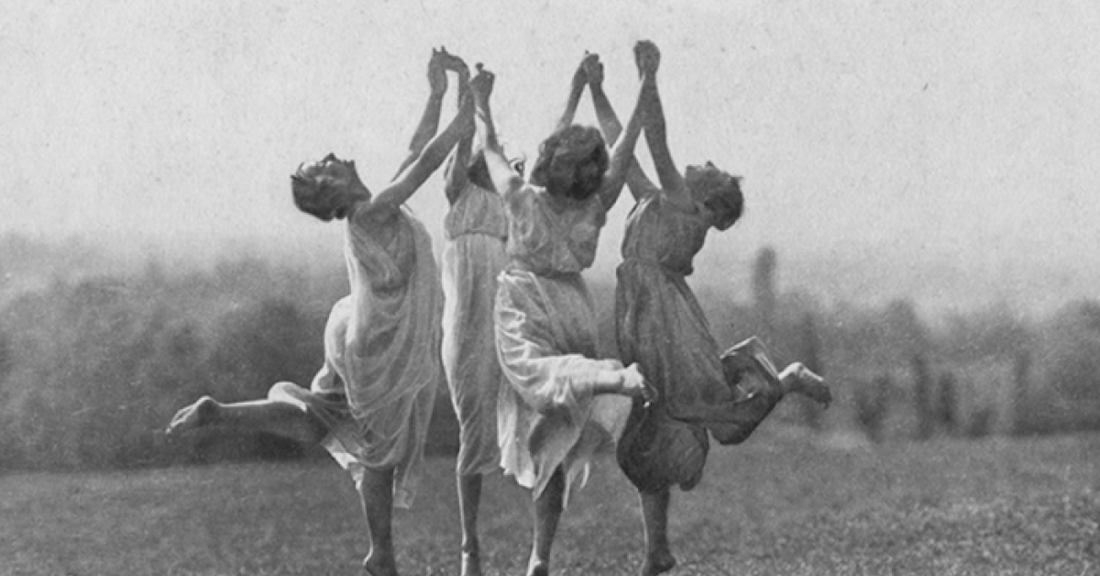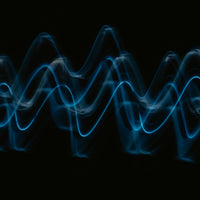Melodic synth chords chirp and hum over a rhythmic bass throb. A crowd of about 100 people whirls about in a kaleidoscope of color and motion. A woman in her 70s in a loose, silk array of pastels twirls in a circle, beaming, with her arms outstretched, palms to the sky, eyes closed. To her right a man in his 40s wearing jeans and a Led Zeppelin t-shirt holds his arms close to his sides and hops in a repetitive pogo-stick motion, up and down. Nearby, a young mother sways to and fro, cradling a baby wrapped in a green cotton sling against her chest. A couple of small children bop and spin in circles around their parents, who are dancing close and slow. This scene might fit the description of an ecstatic dance gathering, but this one happened to take place on a rooftop on the east side of the Willamette River in Portland, Oregon in 2018. When I asked people what drew them to ecstatic dance, many shared that they’d been attending for years—sometimes decades. Everyone I talked to shared something about how letting their bodies move freely with the music, alongside other people, brought them joy, presence and a sense of connection to themselves and the other dancers.
Science is catching up to the lived experiences of the people I met on that rooftop. A 2021 study conducted by UCLA Health, titled “'Free moving’ dance has healing benefits for mental health” found “conscious, or ecstatic, dance helps those struggling with depression and anxiety.” The study surveyed 1,000 dancers across the world, and was published in the journal Complementary Therapies in Clinical Practice.
What Are The Benefits of Dance?
The benefits of free dance seem “undeniable,” according to the study’s senior author, Prabha Siddarth who is a research statistician at the Jane and Terry Semel Institute for Neuroscience and Human Behavior at UCLA. As UCLA Health notes, 98% of people surveyed said dancing freely improved their mood, and “[l]arge percentages also reported that conscious dance helped them let go of distressing thoughts and gave them greater confidence and more compassion,”
As Gabrielle Roth, the creator and founder of the experimental, meditative free dance practice known as 5Rhythms, famously put it:
“If you want to give birth to your true self, you are going to have to dig deep down into that body of yours and let your soul howl. Sometimes you have to take a leap of faith and trust that if you turn off your head, your feet will take you where you need to go.”
The practice of 5Rhythms began in the 70s in New York City. It drew inspiration from a variety of modalities—from meditation, to yoga and other eastern philosophies, to shamanism, to transpersonal psychology and beyond. It was embedded in the human potential movement and has inspired free dance and ecstatic dance offerings around the world over the years—including that of Sacred Circle, which has offered ecstatic dance to Portlanders for 20 years (and, fun fact, is technically a church).
“Gabrielle [Roth] brought in a bunch of important pieces, one of the most important being the, concept of dance as a path through a personal journey, and through a psychological process,” says Gene Zilberstein, who co-founded the Sacred Circle’s ecstatic dance with a group of fellow dancers in 2004. Zilberstein co-facilitates Sacred Circle, and over the years the offering has grown to draw crowds upwards of 250 people weekly (though with the COVID-19 pandemic, the numbers have been closer to 100 or so per gathering).
He shares that Roth often described the musical experience of the free dance format as a wave that starts slow, builds intensity in the middle and ends quietly.
“That wave is a path that you can use to support people traveling their own way through their own particular journeys,” he says, noting that Sacred Circle bases its DJ sets and event frameworks on Roth’s model.
Tia Zilberstien, who met Gene and joined the Sacred Circle community in 2005 and co-facilitates the ecstatic dance gatherings, says people who come to dance are often working through heavy emotions like grief, heartache, and loss. While their ecstatic dances are typically non-verbal experiences, she says the bonds created on the dancefloor can be profound.
“There's an unspoken connection that happens when you're dancing that is, it's kind of hard to describe because it's unspoken,” she says. “You kind of get down to the very atavistic, primal essence of someone when you're in movement.”
Primal indeed. We’ve all seen the way babies naturally bounce and bop to music. Babies were born to dance—and it makes them smile—as detailed in a 2010 study by the University of New York.
"We also found that the better the children were able to synchronize their movements with the music the more they smiled,” wrote the study’s authors.
Dance Has Influenced Our Lives for Much Longer Than We Realize
We humans have been dancing freely and intuitively for over a million years—likely since the times of our early hominid ancestors, or possibly even our apehood—as described in a 2010 LiveScience article by Denise Chow titled “Why Do Humans Dance?”. We apparently danced our way through the Ice Age and other major calamities, and our earliest ancestors were getting down to get down, as evidence shows early hominid mating rituals expressed in dance. A 2017 Scientific American article breaks down the sweeping evidence that dance is probably a big part of why we’re alive today.
As it turns out, we really should all be dancing like nobody’s watching. Or, as Roth said, “Energy moves in waves. Waves move in patterns. Patterns move in rhythms. A human being is just that—energy, waves, patterns, rhythms. Nothing more. Nothing less. A dance.”
April M. Short is a journalist, editor, yoga teacher and feminine rites practitioner. She's an editor at the Independent Media Institute and helped co-found multiple psychedelics-focused media outlets. She has spent more than a decade in independent media working in both digital and print journalism, and her writing is published in the San Francisco Chronicle, LA Yoga, Salon, The Conversation and many others. Follow her yoga and ritual work on Instagram: @AprilClarkYoga.




